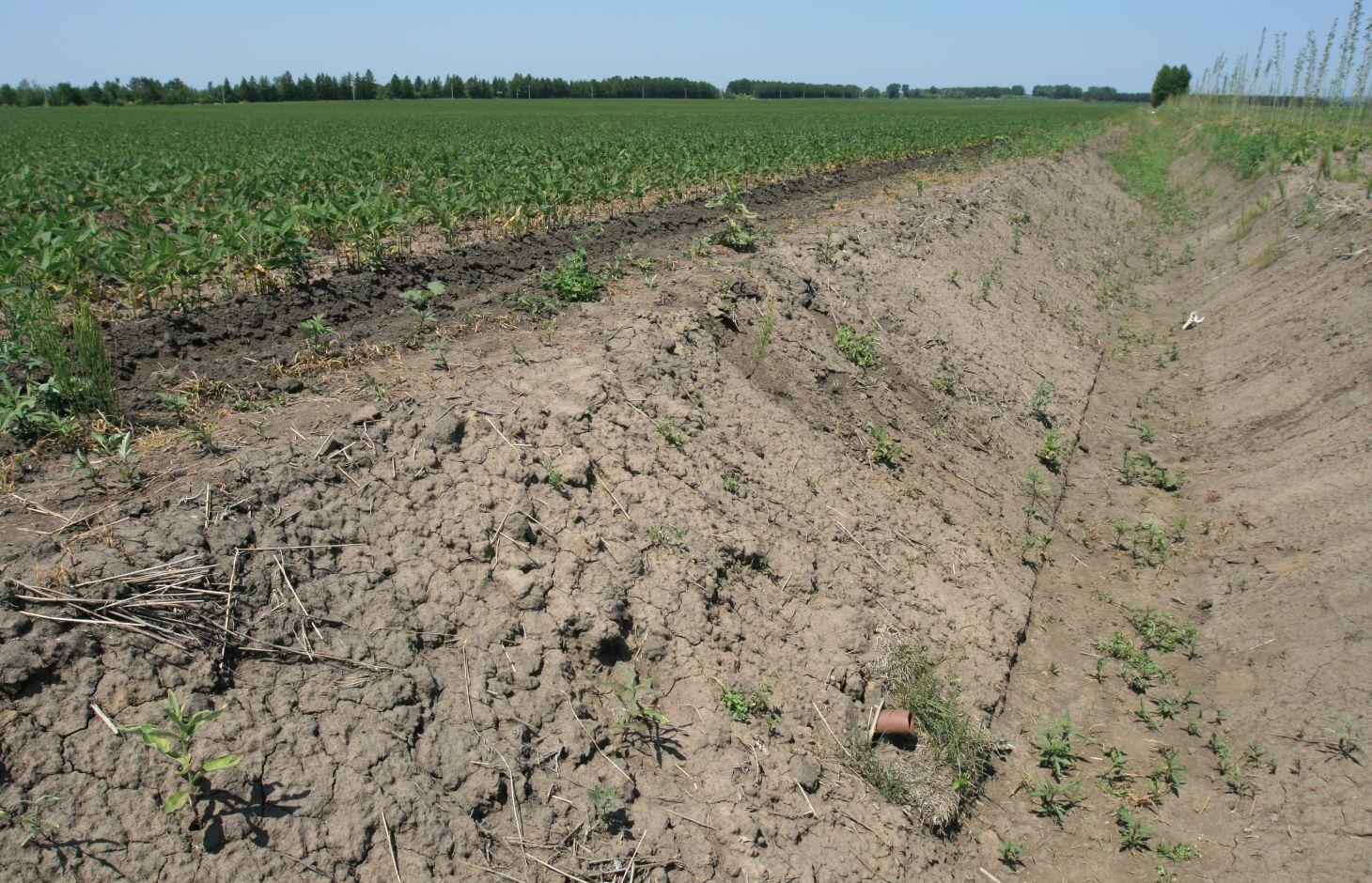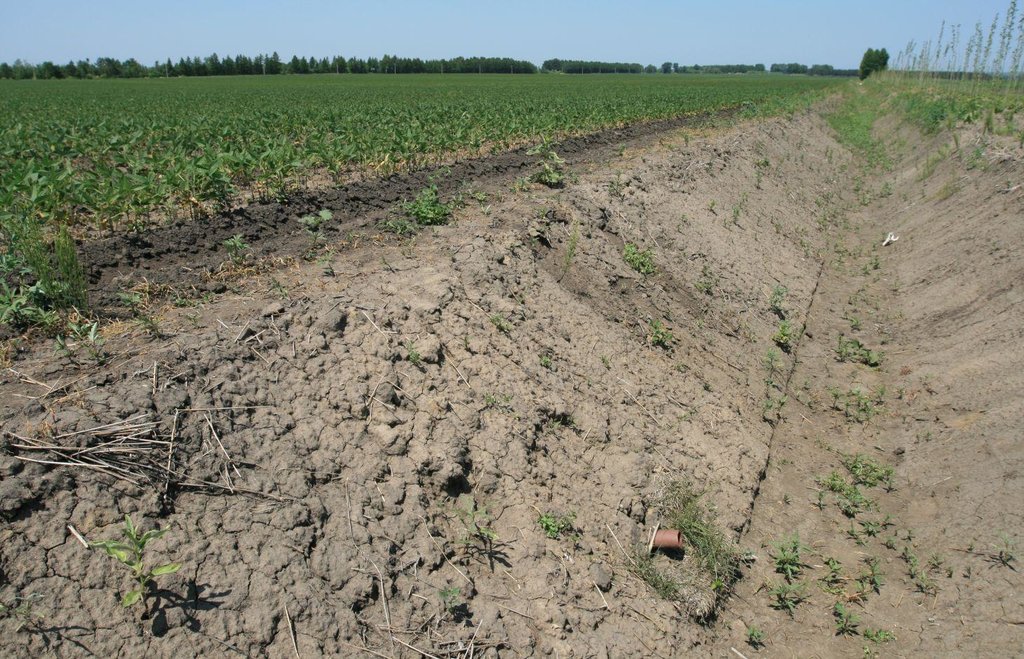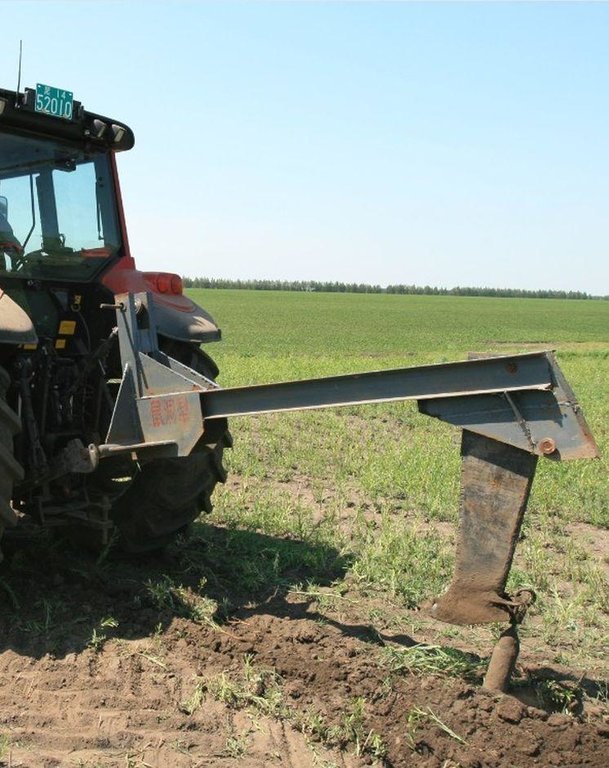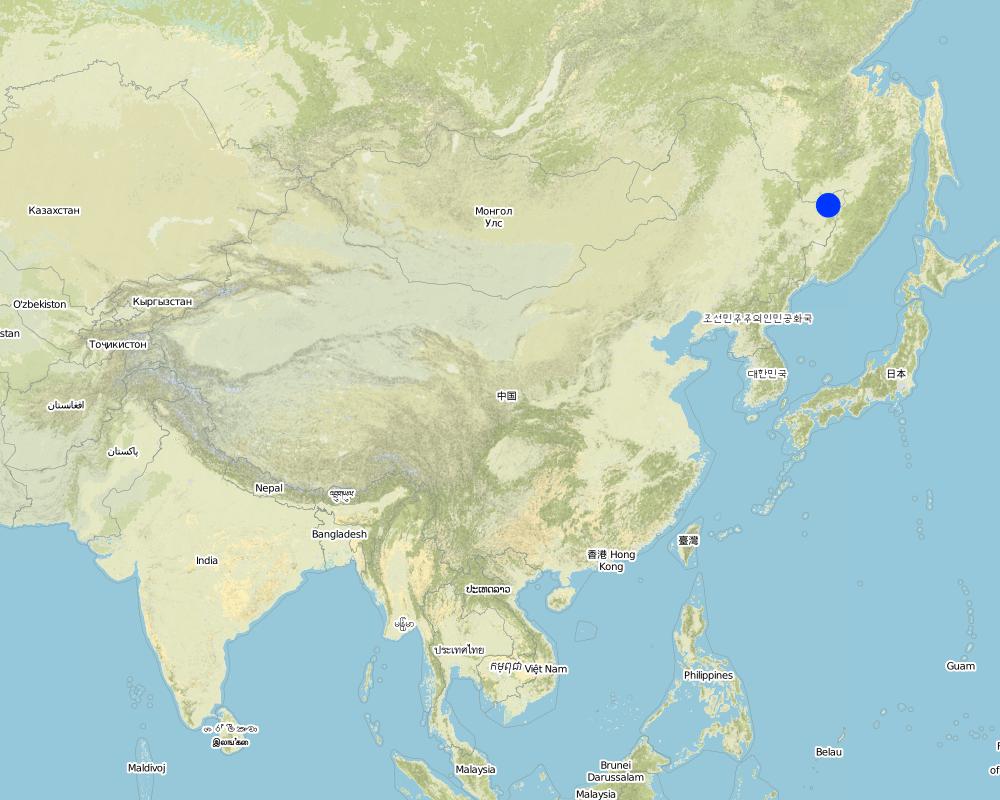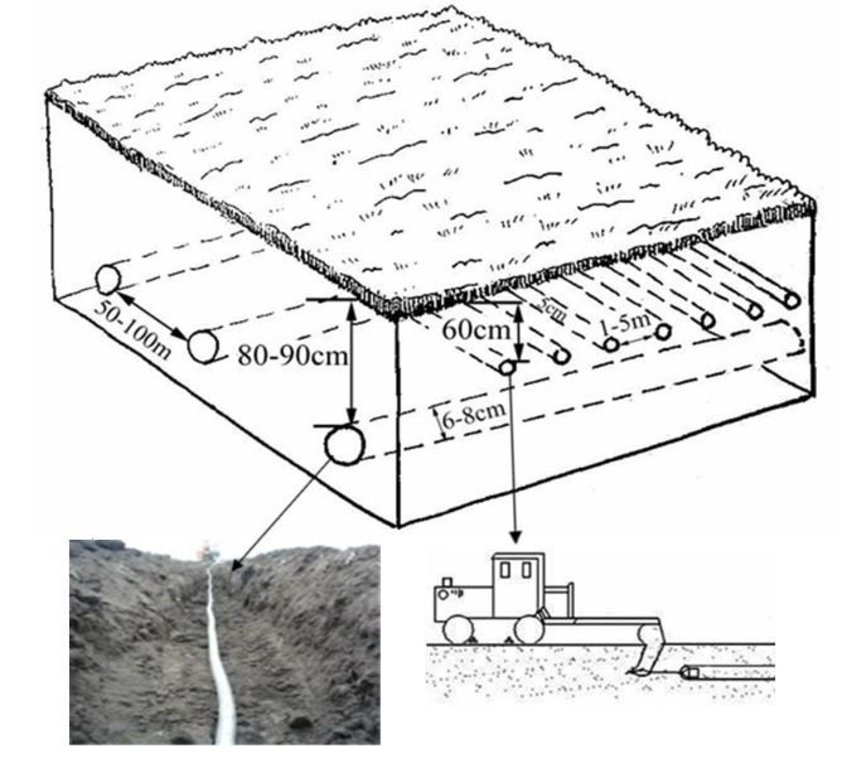Closed Pipe-conduit [中国]
- 创建:
- 更新:
- 编制者: Mei Zhao
- 编辑者: –
- 审查者: Deborah Niggli, Alexandra Gavilano
Rat tunnel tillage
technologies_1556 - 中国
查看章节
全部展开 全部收起1. 一般信息
1.2 参与该技术评估和文件编制的资源人员和机构的联系方式
SLM专业人员:
Lingqin Meng
Division of water and soil conservation, Songliao water resources commission, ministry of water resources P.R. China
中国
有助于对技术进行记录/评估的机构名称(如相关)
Songliao Water Resources Commission (Songliao Water Resources Commission) - 中国1.3 关于使用通过WOCAT记录的数据的条件
编制者和关键资源人员接受有关使用通过WOCAT记录数据的条件。:
是
1.4 所述技术的可持续性声明
这里所描述的技术在土地退化方面是否存在问题,导致无法被认为是一种可持续的土地管理技术?:
否
2. SLM技术的说明
2.1 技术简介
技术定义:
A Rat tunnel is a kind of subdrainage. It is a drainage duct formed through extrusion or oscillation in soil layer by pulling a mole plough with a tractor. The rat tunnels in a field should be used together with a concealed conduit drainage system in order to safely and quickly drains the water in the rat tunnels and avoid field collapses incurred by poor drainage and washings on the rat tunnels.
2.2 技术的详细说明
说明:
Rat tunnels are suitable for the regions with sticky and heavy soil, thick soil layer, and lower infiltration rates, high underground water level and where waterlogs are very likely to happen. By applying the rat tunnels, infiltration can be increased, soil salinization can be prevented without affecting the growth of the crops and occupying croplands. Good effect can be achieved by combining rat tunnels with closed conduits in application. Closed drainage refers to burying the drain pipes underground and letting the underground water flow along the fissures between the pipes and penetrate into the tubes and drained. In a field, if rat tunnels and closed conduits are combined for use, the rat tunnels constitute the first-grade drainage system, the closed conduits constitute the second-grade drainage system; the stagnant water in the plough layer penetrates through the soil and rat fissures and converges into the rat tunnels; While draining the water inside themselves to the outside, the rat tunnels collect the inside stagnant water and guide the water into the closed conduits, through which the water is discharged. In this way, the surface water can be discharged in a relatively thorough way.
Increase of soil infiltration, rapid discharge of direct surface runoffs, prevention of soil salinization.
In building such a project, the closed conduits should be built first, followed by the building of the rat tunnels; the closed conduits should be under the rat tunnels, the included angle between a closed conduit and a rat tunnel should be 90°.
The gap between two neighboring laid closed conduits should be 50m-100m. The burying depth of a closed conduit should be 80cm-90cm, the area around the closed conduit should be evenly laid with a layer of coarse gravels 5-8cm in thickness. After the project on the closed conduits in a field is accomplished, restore the flatness of the field surface, then undertake the operation on the rat tunnels.
In building the rat tunnels, a tractor is directly applied to pull the mole plough in accordance with the designed distances. When the tractor moves forward, the mole plough goes deep into a specified depth(generally 60cm) of soil layer and generates through piercing the soil along the direction of the forward motion of the tractor a tunnel(rat tunnels) whose diameter is equal to bullet diameter and which is in parallel with the ground surface. The separation distance between two neighboring rat tunnels is 1-5m. The service life is generally 2-5 years. If the rate of flow of a field obviously decreases, new rat tunnels should be built by averting the original routes.
After a rainfall, check whether the rat tunnels have collapsed. The service life of the newly laid closed conduits is over 20, however, new rat tunnels should be built every two years.
Rat tunnels are mainly distributed on the Three River Plain, which is the largest marsh distribution area. It has a total population of about 8.625, with the population density being about 79/km2. With the annual average temperature being 1℃-4℃,being warm in summer with the average temperature being over 22℃, having an annual amount of precipitation of 500-600 mm with the rainfall seasons mainly concentrated in the hot seasons from June to August, the Three River Plain is suitable for the growth of crops. The area is affluent in water resources, with the total quantity reaching about 18.764 billion/m3. In this area, the per capita cultivated land area is about 5 times of the average level in China. There are also about 2.52 millions of theropencedrymion distributed in the terrains with low mountains and hills.
2.3 技术照片
2.5 已应用该技术的、本评估所涵盖的国家/地区/地点
国家:
中国
区域/州/省:
Hei Longjiang
有关地点的进一步说明:
San Jiang Plain
具体说明该技术的分布:
- 均匀地分布在一个区域
如果不知道精确的区域,请注明大致覆盖的区域:
- > 10,000 平方千米
注释:
This technology is widely used in San Jiang Plain.
Map
×2.6 实施日期
如果不知道确切的年份,请说明大概的日期:
- 10-50年前
2.7 技术介绍
详细说明该技术是如何引入的:
- 在实验/研究期间
3. SLM技术的分类
3.1 该技术的主要目的
- 减少、预防、恢复土地退化
3.2 应用该技术的当前土地利用类型

农田
- 一年一作
每年的生长季节数:
- 1
具体说明:
Longest growing period in days: 150, Longest growing period from month to month: From April to September
注释:
Major land use problems (compiler’s opinion): high underground water level, lower infiltration rates,Soil salinization
Major land use problems (land users’ perception): It's hard to drainage excess water. Lower soil fertility
3.4 供水
该技术所应用土地的供水:
- 雨养
3.5 该技术所属的SLM组
- 引水和排水
3.6 包含该技术的可持续土地管理措施

结构措施
- S11:其它
3.7 该技术强调的主要土地退化类型

土壤水蚀
- Wt:表土流失/地表侵蚀
- Wm:块体运动/滑坡

土壤风蚀
- Et:表土流失

物理性土壤退化
- Pc:压实
注释:
Causes of degradation: soil management (Backward management modes), change of seasonal rainfall (The rainy seasons mainly focus on summer), Heavy / extreme rainfall (intensity/amounts) (The land can't drainge the excess water after downpours), population pressure (Population pressure makes extensive cultivation in this region), land tenure (As the lands are owned by country or by peasant communities, the peasants will not protect their land initiatively.), education, access to knowledge and support services (The channels for the local peasants get knowledge are few, and they will not learn knowledge initiatively.), governance / institutional
3.8 防止、减少或恢复土地退化
具体数量名该技术与土地退化有关的目标:
- 修复/恢复严重退化的土地
4. 技术规范、实施活动、投入和成本
4.1 该技术的技术图纸
技术规范(与技术图纸相关):
Diameter of closed conduit: 6-8cm, separation distance between two neighboring closed conduits: 50-100m, burying depth: 80-90cm: Diameter of rat tunnel: 5cm, separation between two neighboring rat tunnels: 1-5m, depth: 35-100cm(generally being 60cm). If the depth of the rat tunnels is >60cm, the depth of the closed conduit should be adequately increased.
Location: Hong Xing Farm. Hei Longjiang Province
Date: 2012-7-19
Technical knowledge required for field staff / advisors: high
Technical knowledge required for land users: high (It's complicate to constructe this technology)
Main technical functions: increase of infiltration
Secondary technical functions: control of dispersed runoff: retain / trap, control of dispersed runoff: impede / retard, control of concentrated runoff: impede / retard, improvement of surface structure (crusting, sealing), improvement of topsoil structure (compaction), improvement of subsoil structure (hardpan), improvement of water quality, buffering / filtering water
Structural measure: Closed conduit
Vertical interval between structures (m): 0
Spacing between structures (m): 50-100
Depth of ditches/pits/dams (m): 8-9
Width of ditches/pits/dams (m): 0.06-0.08
Length of ditches/pits/dams (m): >50
Structural measure: Rat tunnel
Vertical interval between structures (m): 0
Spacing between structures (m): 1-5
Depth of ditches/pits/dams (m): 6
Width of ditches/pits/dams (m): 0.05
Length of ditches/pits/dams (m): >50
Construction material (other): A closed conduit is a kind of corrugated plastic conduit with the diameter generally being 6-8cm and
Slope (which determines the spacing indicated above): 0%
Lateral gradient along the structure: 0%
作者:
Zhao Mei, Beijing Normal University
4.2 有关投入和成本计算的一般信息
其它/国家货币(具体说明):
Ren Min Bi
如相关,注明美元与当地货币的汇率(例如1美元=79.9巴西雷亚尔):1美元=:
6.25
注明雇用劳工的每日平均工资成本:
60.00
4.3 技术建立活动
| 活动 | 时间(季度) | |
|---|---|---|
| 1. | Layout the line of Closed Conduit | Spring |
| 2. | Laid closed conduits | Spring |
| 3. | Build rat tunnels.The tractor is directly applied to pull the mole plough in accordance with the designed distances. | Spring |
4.4 技术建立所需要的费用和投入
| 对投入进行具体说明 | 单位 | 数量 | 单位成本 | 每项投入的总成本 | 土地使用者承担的成本% | |
|---|---|---|---|---|---|---|
| 劳动力 | labour | ha | 1.0 | 64.0 | 64.0 | |
| 设备 | first machine | ha | 1.0 | 224.0 | 224.0 | |
| 设备 | second machine | ha | 1.0 | 24.0 | 24.0 | |
| 施工材料 | corrugated plastic conduit | ha | 1.0 | 640.0 | 640.0 | |
| 技术建立所需总成本 | 952.0 | |||||
| 技术建立总成本,美元 | 152.32 | |||||
注释:
Duration of establishment phase: 1 month(s)
4.5 维护/经常性活动
| 活动 | 时间/频率 | |
|---|---|---|
| 1. | Build rat tunnels. | every two years |
4.6 维护/经常性活动所需要的费用和投入(每年)
| 对投入进行具体说明 | 单位 | 数量 | 单位成本 | 每项投入的总成本 | 土地使用者承担的成本% | |
|---|---|---|---|---|---|---|
| 设备 | second machine | ha | 1.0 | 24.0 | 24.0 | |
| 技术维护所需总成本 | 24.0 | |||||
| 技术维护总成本,美元 | 3.84 | |||||
注释:
Machinery/ tools: Mole Plough, refer to the photo of technical drawing.
The accounted costs for each hectare are as follows: Depth, diameter and spacing on closed conduit: being 90cm, 8cm and 80m respectively, the closed conduits with a total length of 200m are required for each hectare. 1. Costs of closed conduit laying: Tractor cost is 224$US ; Expense of the conduit materials is 640$US; Labor expense is 64$US. 2. Costs of rat tunnel building: Machinery cost: 24$US/hectare (the operation efficiency: 30 hectare/day). No maintenance cost. However, new rate tunnels should be built with the same costs(24$US) every 2 years. The service life of the closed conduits is over 20 years.
4.7 影响成本的最重要因素
描述影响成本的最决定性因素:
The most determinate factors is the cost of corrugated plastic conduit.
5. 自然和人文环境
5.1 气候
年降雨量
- < 250毫米
- 251-500毫米
- 501-750毫米
- 751-1,000毫米
- 1,001-1,500毫米
- 1,501-2,000毫米
- 2,001-3,000毫米
- 3,001-4,000毫米
- > 4,000毫米
农业气候带
- 半湿润
- 半干旱
Thermal climate class: temperate, boreal
5.2 地形
平均坡度:
- 水平(0-2%)
- 缓降(3-5%)
- 平缓(6-10%)
- 滚坡(11-15%)
- 崎岖(16-30%)
- 陡峭(31-60%)
- 非常陡峭(>60%)
地形:
- 高原/平原
- 山脊
- 山坡
- 山地斜坡
- 麓坡
- 谷底
垂直分布带:
- 0-100 m a.s.l.
- 101-500 m a.s.l.
- 501-1,000 m a.s.l.
- 1,001-1,500 m a.s.l.
- 1,501-2,000 m a.s.l.
- 2,001-2,500 m a.s.l.
- 2,501-3,000 m a.s.l.
- 3,001-4,000 m a.s.l.
- > 4,000 m a.s.l.
5.3 土壤
平均土层深度:
- 非常浅(0-20厘米)
- 浅(21-50厘米)
- 中等深度(51-80厘米)
- 深(81-120厘米)
- 非常深(> 120厘米)
土壤质地(表土):
- 中粒(壤土、粉土)
表土有机质:
- 中(1-3%)
5.4 水资源可用性和质量
地下水位表:
5-50米
地表水的可用性:
过量
水质(未处理):
仅供农业使用(灌溉)
5.5 生物多样性
物种多样性:
- 中等
5.6 应用该技术的土地使用者的特征
生产系统的市场定位:
- 混合(生计/商业)
- 商业/市场
非农收入:
- 收入的10-50%
相对财富水平:
- 平均水平
- 丰富
个人或集体:
- 团体/社区
机械化水平:
- 手工作业
- 机械化/电动
性别:
- 男人
说明土地使用者的其他有关特征:
Land users applying the Technology are mainly common / average land users
Population density: 10-50 persons/km2
Annual population growth: < 0.5%
10% of the land users are very rich.
45% of the land users are rich.
35% of the land users are average wealthy.
10% of the land users are poor.
Off-farm income specification: Apart from farming, the main works of the local people involve doing works for others in cities and towns or doing business.
5.7 应用该技术的土地使用者使用的平均土地面积
- < 0.5 公顷
- 0.5-1 公顷
- 1-2 公顷
- 2-5公顷
- 5-15公顷
- 15-50公顷
- 50-100公顷
- 100-500公顷
- 500-1,000公顷
- 1,000-10,000公顷
- > 10,000公顷
这被认为是小规模、中规模还是大规模的(参照当地实际情况)?:
- 大规模的
5.8 土地所有权、土地使用权和水使用权
土地所有权:
- 州
- 社区/村庄
土地使用权:
- 社区(有组织)
用水权:
- 社区(有组织)
注释:
The lands are owned by country or by peasant communities.
5.9 进入服务和基础设施的通道
健康:
- 贫瘠
- 适度的
- 好
教育:
- 贫瘠
- 适度的
- 好
技术援助:
- 贫瘠
- 适度的
- 好
就业(例如非农):
- 贫瘠
- 适度的
- 好
市场:
- 贫瘠
- 适度的
- 好
能源:
- 贫瘠
- 适度的
- 好
道路和交通:
- 贫瘠
- 适度的
- 好
饮用水和卫生设施:
- 贫瘠
- 适度的
- 好
金融服务:
- 贫瘠
- 适度的
- 好
6. 影响和结论性说明
6.1 该技术的现场影响
社会经济效应
生产
饲料生产
饲料质量
畜牧生产
木材生产
产品多样性
生产区域
水资源可用性和质量
饮用水的可用性
收入和成本
农业收入
收入来源的多样性
经济差异
工作量
社会文化影响
文化机会
社区机构
国家机构
SLM/土地退化知识
冲突缓解
社会经济弱势群体的情况
contribution to human well-being
注释/具体说明:
Local peasants learn some knowledges of soil and water conservation though this technology.
生态影响
水循环/径流
水量
水质
水的回收/收集
地表径流
多余水的排放
地下水位/含水层
蒸发
土壤
土壤水分
土壤流失
土壤结壳/密封
盐度
6.2 该技术的场外影响已经显现
水资源可用性
旱季稳定可靠的水流
下游洪水
下游淤积
地下水/河流污染
缓冲/过滤能力
对邻近农田的破坏
对公共/私人基础设施的破坏
6.3 技术对渐变气候以及与气候相关的极端情况/灾害的暴露和敏感性(土地使用者认为的极端情况/灾害)
渐变气候
渐变气候
| 季节 | 增加或减少 | 该技术是如何应对的? | |
|---|---|---|---|
| 年温度 | 增加 | 好 |
气候有关的极端情况(灾害)
气象灾害
| 该技术是如何应对的? | |
|---|---|
| 局地暴雨 | 好 |
| 局地风暴 | 好 |
气候灾害
| 该技术是如何应对的? | |
|---|---|
| 干旱 | 好 |
水文灾害
| 该技术是如何应对的? | |
|---|---|
| 比较和缓的(河道)洪水 | 好 |
其他气候相关的后果
其他气候相关的后果
| 该技术是如何应对的? | |
|---|---|
| 缩短生长期 | 好 |
6.4 成本效益分析
技术收益与技术建立成本相比如何(从土地使用者的角度看)?
短期回报:
消极
长期回报:
稍微积极
技术收益与技术维护成本/经常性成本相比如何(从土地使用者的角度看)?
短期回报:
轻度消极
长期回报:
积极
6.5 技术采用
- > 50%
如若可行,进行量化(住户数量和/或覆盖面积):
95% of all households
在所有采用这项技术的人当中,有多少人是自发的,即未获得任何物质奖励/付款?:
- 0-10%
注释:
This technology only be implemented by farmers, because it's too expensive for peasant to afford it. If farmers implement the technology, the local government will organization peasants to help farmers, the government pay for the wages.
A few of land users will implement the technology without any external material support.
There is a little trend towards spontaneous adoption of the Technology
6.7 该技术的优点/长处/机会
| 编制者或其他关键资源人员认为的长处/优势/机会 |
|---|
| Fast drainage of surface water |
| Prevention of soil salination |
6.8 技术的弱点/缺点/风险及其克服方法
| 土地使用者认为的弱点/缺点/风险 | 如何克服它们? |
|---|---|
| New rat tunnels should be built every two years |
| 编制者或其他关键资源人员认为的弱点/缺点/风险 | 如何克服它们? |
|---|---|
| Complicated in construction, big investment | seeking other substitutes |
7. 参考和链接
7.1 信息的方法/来源
- 实地考察、实地调查
- 与土地使用者的访谈
(现场)数据是什么时候汇编的?:
28/02/2013
7.2 参考可用出版物
标题、作者、年份、ISBN:
Techniques standard for comprehensive control of soil erosion in the black soil region, Author: Shen Bo; Meng Lingqin, Years: 2009
可以从哪里获得?成本如何?
Internal book
链接和模块
全部展开 全部收起链接
无链接
模块
无模块


